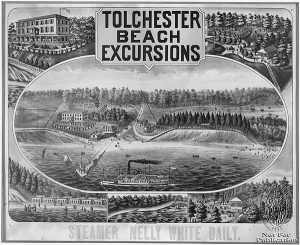
About 2,500 passengers could ride on Louise to Tolchester Beach at one time. These passengers each paid 50 cents for their round trip tickets. When they reached the amusement park, they purchased more tickets for rides like a Ferris wheel, games of chance, and vaudeville shows. Some amusement parks even had dancing bears. The same company that owned the steamboat operated these attractions.
It took many crew members to run Louise. There was the captain, his first mate, and his second mate. These men were responsible for giving the correct orders to the men who worked the controls for moving and steering the boat. The captain's orders were carried out by the workleader and his two helpers, who were called deckhands. These men handled the lines when the boat was docking and helped steer the boat when she was underway. The captain also relied on the chief engineer. The engineer usually had about 3 helpers. These men kept the engines running. Then there were coal shovelers. There were usually three men whose job was to supply the boat with a constant stream of coal, so that her boiler could keep producing steam. There were also workers on the boat to serve the passengers. You could buy dinner on the boat as well as lemonade and ice cream. About 30 people worked on the boat serving passengers food and making sure they were comfortable.
Once you arrived at Tolchester Beach, if you were a child, you would have been asked to dash off the boat at the earliest possible moment so that you could race to the "picnic grove" and save the best picnic table for your family. You would save the table by sitting on it. Your family would follow you in a slower fashion carrying baskets full of fried chicken, lemonade, pies, and other wonderful things to eat. Your family would spend the day picnicking and enjoying the rides.
There was a merry-go-round with hand carved animals, a very mild roller coaster (or "inclined railway" as they were called in 1885), and swings built out over the water. You might have bought a treat of cotton candy or won a canary in a game of chance. But when evening came, you would once again board Louise and steam back to Baltimore under the light of the moon and the stars.
The year 1877 saw the opening of an amusement park on ten acres of land, a somewhat primitive park, under the supervision of Captain Eliason. The resort included picnic grounds with tables, a few concessions, a bath house, a hand propelled merry-go-round, and a hand organ pulled by a goat. Thus was the beginning of the most popular beach resort along the shores of the Chesapeake Bay, destined to provide entertainment and fond lifelong memories to millions of patrons during the next eighty-five years. Tolchester Beach, in its prime, expanded to 155 acres and was serviced by six steamers and a ferry. Happy visitors stayed at the great summer hotel on the top of the bluff. Here were to be found a dance hall, a roller coaster, bowling alleys, a bingo parlor, a roller skating rink, the whip, dodgems, pony and goat carts, boat rides, a miniature steam train named Jumbo, novelty and candy shops, and popcorn, ice cream, hot dogs and kewpie doll stands.
At its height, Tolchester Beach attracted as many as 20,000 visitors a weekend from across the bay an the Eastern Shore. After flourishing for eight-five years, Tolchester Beach passed from the scene, finally closing in 1962.
